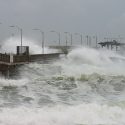UW-Madison study returns biology to the basics
We may be living in the age of biotechnology, but science still has some very basic questions to answer. And, one of them is “What microbes live in lakes?”
This may seem like a simple problem, but the solution could contain invaluable information. For example, the discovery of new microbes, such as bacteria, led to the development of important drugs, such as streptomycin (the first antibiotic effective in treating tuberculosis), and ultimately to polymerase chain reaction, a gene amplification technique biologists throughout the world use to study DNA.
Besides, “knowing who is doing what in lakes – and when and why and where – will improve our understanding of lakes and help us develop strategies to manage them better,” says agronomy professor Eric Triplett.
Triplett is one of several UW–Madison faculty members participating in a National Science Foundation program called, “Microbial Observatories.” While each researcher studies different microbial habitats – caterpillar guts or Alaskan forest soil, for example – they all want to discover and characterize the unknown microscopic organisms living in those ecosystems.
“We may have more expensive equipment and more sophisticated methods, but our research goals are analogous to those of early biologists,” says Angela Kent, a postdoctoral researcher working on the Wisconsin lakes microbial observatory. “We begin with a period of discovery – an inventory of microorganisms. What follows will be experiments to understand their roles in lakes.”
Triplett’s group collects water samples from the middle of Crystal Bog and Crystal lakes in northern Wisconsin, and Lake Mendota in Madison. These samples contain dozens of never-before-seen species of bacteria.
“Despite the fact that bacteria play a major role in important processes in lakes, such as nutrient and carbon cycling, we know very little about them,” says Triplett.
For each sample, the group counts the different types of bacteria and then describes the microbial communities.
But, these researchers can’t just look at the bacteria and jot down morphological differences, as earlier biologists had done. Because the bacteria are microscopic and researchers are unable to culture them in the lab, a different technique must be used. Says Kent, “We have to describe them by their genetics. The molecular information helps us tell them apart.”
By measuring the length of a particular fragment of a ribosomal ribonucleic acid (RNA) gene found in each bacterium, the group can classify them into types. By counting how many there are of each type in a given sample, the researchers can describe the microbial communities.
Taking this census of bacteria in lakes is just one part of the UW–Madison project. As Triplett says, “We want to know how bacterial communities in lakes respond to changes in the environment, including water chemistry and weather.”
The group gathers this data through another UW–Madison study – a long-term ecological research project, also funded by NSF, which monitors the physical, chemical and biological changes in Wisconsin lakes over time.
Already, Triplett and his colleagues have observed significant changes in community structure on a weekly basis. Preliminary findings show that water temperature plays a role in determining the structure of the bacterial community; changes in these communities correspond with changes in other organismal communities, such as algae. The findings also suggest that geographic location and water chemistry lead to significant differences in bacterial communities across lakes.
“With the changes in the earth’s climate and with the invasion of exotic species, such as the zebra mussel, in our lakes, this is a very interesting time to study changes in microbial communities,” says Triplett.
Preliminary findings from this work will be presented at a national workshop for researchers participating in the NSF Microbial Observatories program in Washington, D.C., Sept. 23-24.
The lake observatory project is now in its third year and the next step, says Triplett, is to understand the genetic differences among certain bacteria. “Our results may never tell people when and where to fish, but they will definitely fill a void in our knowledge of lakes.”


